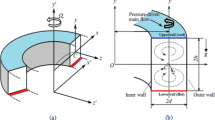Abstract
The compressible mixing layer is an important physical model to describe the mixing enhancement in scramjet combustors. The downstream coherent structures are normally regarded as the main contribution of the entrainment in the compressible mixing layer. In this study, three cases of the compressible mixing layer of convective Mach number Ma = 0.4 are numerically simulated through the Lagrangian coherent structure (LCS) method to show that the entrainment process in the compressible mixing layer is closely related to the upstream hidden structures termed as the “entrainment formation structures”. The entrainment formation structures consist of a series of inclined control bodies that are identical and nested to one another upstream the compressible mixing layer. In combination with the separation of the flow properties of coherent structures, the entrainment characteristics in the compressible mixing layer can be evaluated by the inclined control bodies of the upstream entrainment formation structures in the upper and lower fluids. Furthermore, with the quantitative analysis of the spatial position of the upstream coherent structure, the entrainment ratio is determined. The study of the entrainment formation and its characteristics helps the effective control of the entrainment performance in the compressible mixing layer.
Similar content being viewed by others
References
Gutmark E. J., Schadow K. C., Yu K. H. Mixing enhancement in supersonic free shear flows [J]. Annual Review of Fluid Mechanics, 1995, 27: 375–417.
Urzay J. Supersonic combustion in air–breathing propulsion systems for hypersonic flight [J]. Annual Review of Fluid Mechanics, 2018, 50: 593–627.
Dimotakis P. E. Turbulent free shear layer mixing and combustion [J]. High Speed Flight Propulsion Systems, 1991, 137: 265–340.
Brown G. L., Roshko A. On density effects and large structure in turbulent mixing layers [J]. Journal of Fluid Mechanics, 1974, 64(4): 775–816.
Slessor M. D., Zhuang M., Dimotakis P. E. Turbulent shear–layer mixing: growth–rate compressibility scaling [J]. Journal of Fluid Mechanics, 2000, 414: 35–45.
Lu G., Lele S. K. Inviscid instability of a skewed compressible mixing layer [J]. Journal of Fluid Mechanics, 1993, 249: 441–463.
Brown G. L. The entrainment and large structure in turbulent mixing layers [C]. 5th Australasian Conference on Hydraulics and Fluid Mechanics, Adelaide, Australia, 1974, 352–359.
Qiu X., Zhang D. X., Lu Z. M. et al. Turbulent mixing and evolution in a stably stratified flow with a temperature step [J]. Journal of Hydrodynamics, 2009, 21(1): 84–92.
Reinaud J., Joly L., Chassaing P. The baroclinic secondary instability of the two–dimensional shear layer [J]. Physics of Fluids, 2000, 12(10): 2489–2505.
Soteriou M. C., Ghoniem A. F. Effects of the free–stream density ratio on free and forced spatially developing shear layers [J]. Physics of Fluids, 1995, 7(8): 2036–2051.
Howland C., Taylor J., Caulfield C. Testing linear marginal stability in stratified shear layers [J]. Journal of Fluid Mechanics, 2018, 839: R4.
Haller G., Yuan G. Lagrangian coherent structures and mixing in two–dimensional turbulence [J]. Physica D, 2000, 147: 352–370.
Peacock T., Haller G. Lagrangian coherent structures: the hidden skeleton of fluid flows [J]. Physics Today, 2013, 66(2): 41–47.
Shadden S. C., DabiriJ. O., Marsden J. E. Lagrangian analysis of fluid transport in empirical vortex ring flows [J]. Physics of Fluids, 2006, 18(4): 047105.
Green M. A., Rowley C. W., Haller G. Detection of Lagrangian coherent structures in three–dimensional turbulence [J]. Journal of Fluid Mechanics, 2007, 572: 111–120.
Ho C. M., Huerre P. Perturbed free shear lyaers [J]. Annual Review of Fluid Mechanics, 1984, 16: 365–424.
Guo G., Liu H., Zhang B. Development of a temporal evolution model for aero–optical effects caused by vortices in the supersonic mixing layer [J]. Applied Optics, 2016, 55(10): 2708–2717.
Wang Z., Yu B., Chen H. et al. Scaling vortex breakdown mechanism based on viscous effect in shock cylindrical bubble interaction [J]. Physics of Fluids, 2018, 30(12): 126103.
Clemens N. T., Mungal M. G. Large–scale structure and entrainment in the supersonic mixing layer [J].Journal of Fluid Mechanics, 1995, 284: 171–216.
Haller G. Lagrangian coherent structures [J]. Annual Review of Fluid Mechanics, 2015, 47: 137–162.
Cheng H. Y., Long X. P., Ji B. et al. 3–D Lagrangianbased investigations of the time–dependent cloud cavitating flows around a Clark–Y hydrofoil with special emphasis on shedding process analysis [J]. Journal of Hydrodynamics, 2018, 30(1): 122–130.
Shadden S. C., Lekien F., Marsden J. E. Definition and properties of Lagrangian coherent structures from finitetime Lyapunov exponents in two–dimensional aperiodic flows [J]. Physica D, 2005, 212: 271–304.
Perez–Munuzuri V. Mixing and clustering in compressible chaotic stirred flows [J]. Physical Review E, 2014, 89(2): 022917.
Perez–Munuzuri V. Clustering of inertial particles in compressible chaotic flows [J]. Physical Review E, 2015, 91(5): 052906.
Chian A. C. L., Rempel E. L., Aulanier G. et al. Detection of coherent structures in turbulent photospheric flows [J]. The Astrophysical Journal, 2014, 786(1): 51–63.
Onu K., Huhn F., Haller G. LCS Tool: A computational platform for Lagrangian coherent structures [J]. Journal of Computational Science, 2015, 7: 26–36.
Guo G. M., Liu H., Zhang B. Numerical study on evolution characteristics of vortices in supersonic mixing layers [J]. Journal of Aeronautics, Astronautics and Aviation, 2016, 48(2): 133–140.
Haller G. A variational theory of hyperbolic Lagrangian coherent structures [J]. Physica D, 2012, 240(7): 574–598.
Author information
Authors and Affiliations
Corresponding author
Additional information
Project supported by the National Natural Science Foundation of China (Grant Nos. 91741113, 91841303).
Biography: Geng Liang (1998-), Male, Undergraduate
Rights and permissions
About this article
Cite this article
Liang, G., Yu, B., Zhang, B. et al. Hidden flow structures in compressible mixing layer and a quantitative analysis of entrainment based on Lagrangian method. J Hydrodyn 31, 256–265 (2019). https://doi.org/10.1007/s42241-019-0027-z
Received:
Revised:
Accepted:
Published:
Issue Date:
DOI: https://doi.org/10.1007/s42241-019-0027-z




